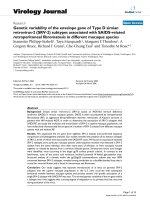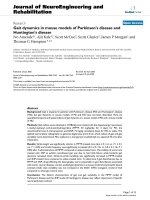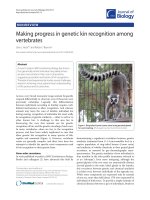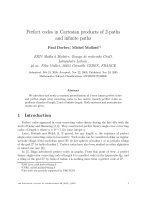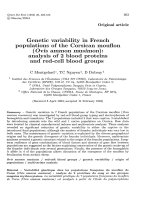Báo cáo sinh học: "Genetic variability in French populations of the Corsican mouflon (Ovis ammon musimon): analysis of 2 blood proteins and red-cell blood groups" pptx
Bạn đang xem bản rút gọn của tài liệu. Xem và tải ngay bản đầy đủ của tài liệu tại đây (623.47 KB, 13 trang )
Original
article
Genetic
variability
in
French
populations
of
the
Corsican
mouflon
(Ovis
ammon
musimon):
analysis
of
2
blood
proteins
and
red-cell
blood
groups
C
Montgelard
TC
Nguyen
2
D
Dubray
1
Institut
des
Sciences
de
l’Évolution
(URA
827
CNRS),
Laboratoire
de
Paléontologie
des
Vertébrés
(EPHE),
UM
II,
CC
64,
3!095
Montpellier
Cedex
5;
2
INRA,
Unité
Polymorphisme
Sanguin
Ovin
et
Caprin,
Laboratoire
des
Groupes
Sanguins,
78350
Jouy-en-Josas;
3
Office
National
de
la
Chasse,
CNERA,
Faune
de
Montagne,
BP
607,!,
84030
Montpellier
Cedex
1,
France
(Received
8
April
1993;
accepted
11
February
1994)
Summary -
Genetic
variation
in
7
French
populations
of
the
Corsican
mouflon
(Ovis
ammon
musimon)
was
investigated
by
red-cell
blood-group
typing
and
electrophoresis
of
hemoglobin
and
transferrin.
The
7
populations
included
3
that
were
captive,
3
established
by
introducing
animals
into
the
wild
and
1
native
population
on
Corsica.
Raw
data
were
treated
by
classical
monofactorial
indexes
and
multivariate
analyses.
These
analyses
revealed
no
significant
reduction
of
genetic
variability
in
either
the
captive
or
the
introduced
feral
populations,
although
the
number
of
founder
individuals
was
very
low
in
both
cases.
The
maintenance
of
genetic
variation
is
explained
by
the
diverse
geographical
origins
and
by
the
genetic
divergence
of
the
founder
individuals.
Moreover,
multivariate
analyses
revealed
a
genetic
structure
related
to
the
origin
of
the
founder
populations.
Long-
term
resilience
of
gene
combinations
of
blood
factors
and
absence
of
gene
flow
between
populations
are
suggested
as
the
factors
explaining
conservation
of
the
genetic
make-up
of
the
founder
individuals
over
several
generations.
Finally,
the
presence
of
the
hemoglobin
A
allele
in
4
of
the
populations
allows
discussion
of
the
emergence
of
the
mouflon
by
feralization
from
archaic
sheep.
Ovis
ammon
musimon
/
red-cell
blood
groups
/
genetic
variability
/
origin
of
populations
/
multivariate
analysis
Résumé -
Variabilité
génétique
chez
les
populations
françaises
du
mouflon
de
Corse
(Ovis
ammon
musimon) :
analyse
de
2
protéines
du
sang
et
des
groupes
sanguins
érythrocytaires.
La
variabilité
génétique
de
7
populations
françaises
du
mouflon
de
Corse
(Ovis
ammon
musimon)
est
analysée
à
partir
de
l’étude
du
polymorphisme
de
l’hémoglobine,
de
la
transferrine
et
des
facteurs
antigéniques
des
groupes
sanguins
érythrocytaires.
Trois
populations
élevées
en
captivité,
3 populations
introduites
sur
le
continent
et
la
population
autochtone
de
Corse
ont
été
analysées.
Les
données
sont
traitées
par
des
indices
monofactoriels
et
des
analyses
multivariées.
Ces
analyses
ne
révèlent
pas
de
réduction
de
la
variabilité
génétique,
ni
pour
les
populations
en
captivité
ni
pour
les
populations
sauvages
introduites,
bien
que
ces
populations
aient
été
fondées
à
partir
d’un
petit
nombre
d’individus.
Le
maintien
de la
variabilité
est
expliqué
par
la
diversité
de
l’origine
géographique
et
la
divergence
génétique
des
animaux
fondateurs.
La
différenciation
génétique
observée
entre
les
populations
est
en
outre
corrélée
avec
l’origine
des
individus
introduits.
Ce
résultat
est
expliqué
en
invoquant
l’absence
de
flux
génique
entre
les
populations
et
par
la
conservation
de
combinaisons
de
gènes
(phénogroupes
des
groupes
sanguins)
sur
plusieurs
générations.
La
présence
de
l’allèle
A
de
l’hémoglobine
permet
aussi
d’aborder
la
question
de
l’origine
du
mouflon
par
marronnage.
Ovis
ammon
musimon
/
groupes
sanguins
érythrocytaires
/
variabilité
génétique
/
origine
des
populations
/
analyses
multivariées
INTRODUCTION
The
present
distribution
of
the
Corsican
mouflon
( Ovis
ammon
mvsimon)
is
essen-
tially
the
result
of
mainland
introductions
from
native
populations
on
Corsican
and
Sardinian
islands
(Tomiczek,
1985;
Uloth
and
Prien,
1985).
Numerous
European
countries
(from
Spain
to
ex-USSR)
and
other
parts
of
the
world
(USA,
Kerguelen
Islands)
also
harbor
introduced
mouflon
populations
(Nadler
et
al,
1971;
ONC,
1985).
In
France,
introductions
took
place
in
the
years
1950-1965
and
wild-living
populations
are
now
present
in
the
mountains
of
the
Alps,
the
Pyr6n6es,
the
C6vennes
and
the
Massif
Central.
The
genetic
variability
of
the
Corsican
mouflon
has
been
assessed
mainly
by
means
of
electrophoretic
analyses,
which
revealed
large
differences
between
populations.
Stratil
and
Boback
(1988)
analyzed
90
mouflons
from
Czechoslovakia
for
10
blood
proteins,
5
of
which
were
polymorphic
(transferrin,
hemopexin,
esterase-A,
X-protein
and
catalase).
A
similar
result
was
obtained
by
Randi
et
al
(1991)
who
found
4
polymorphic
loci
(hexokinase,
isocitrate
deshydrogenase,
glucose-6-phosphate
dehydrogenase
and
malico-enzyme)
among
the
33
loci
scored
in
10
Italian
individuals.
On
the
other
hand,
the
study
of
Hartl
(1990)
revealed
a
very
low
biochemical
variability
in
4
populations
from
the
Austrian
Alps:
only
one
locus
(esterase-2)
of
the
31
protein
systems
studied
was
polymorphic.
The
difference
between
the
latter
results
is
worth
noting
considering
that
22
loci,
including
the
5
polymorphic
loci
mentioned,
were
common
to
both
studies.
In
French
mouflon
populations,
genetic
diversity
was
determined
for
20
captive
individuals
(Jardin
des
Plantes
from
Paris
and
INRA
from
Jouy-en-Josas).
Elec-
trophoresis
of
transferrin
and
hemoglobin
(Nadler
et
al,
1971;
Bunch
et
al,
1978)
showed
that
both
loci
were
polymorphic
and
the
analysis
of
red-cell
blood
groups
(Nguyen
and
Bunch,
1980;
Bunch
and
Nguyen,
1982)
indicated
a
great
proximity
between
domestic
sheep
and
the
Corsican
mouflon.
In
the
present
paper,
we
analyse
genetic
variation
in
7
French
populations
(3
captive
and
4
wild-living)
by
blood
typing
and
by
electrophoresis
of
transferrin
and
hemoglobin.
The
aim
of
this
study
was
to
determine
the
effects
of
founder
events
on
the
genetic
variability
of
introduced
mouflon
populations.
Genetic
variation
and
structure
are
discussed
in
relation
to
the
history
of
the
introductions
(origin
and
number
of
founder
individuals).
MATERIALS
AND
METHODS
Animals
Blood
samples
were
collected
from
172
mouflons
belonging
to
3
captive
populations
(Paris,
Jouy-en-Josas
and
Lunaret)
and
4
feral
ones
(Corsica,
Bauges,
Caroux
and
Italy)
(table
I).
Genetic
systems
Polymorphism
of
transferrin
and
hemoglobin
was
detected
by
starch-gel
elec-
trophoresis
(Nguyen
and
Bunch,
1980)
and
by
electrofocalisation
in
the
case
of
hemoglobin.
Genetic
distances
were
calculated
from
allelic
frequencies
using
Gre-
gorius’
distance,
which
satisfies
all
the
properties
of
a
mathematical
distance
(Gre-
gorius,
1984).
Relationships
between
populations
were
inferred
using
the
Neighbor
program
of
the
Phylip
package
(Felsenstein,
1990).
Seven
genetic
systems
of
red-cell
blood
groups
(OEA:
ovine
erythrocyte
antigens)
were
analysed:
OEA-A,
B, C,
D,
M,
R and
F30
(Committee
on
Genetic
Nomen-
clature
of
Sheep
and
Goat;
Nguyen,
1986).
Twenty-five
different
sheep
reagents
were
tested,
corresponding
to
the
factors,
Aa,
Ab
and
A16
for
OEA-A;
Bb,
Be,
Bd,
Be,
Bf,
Bg,
Bh,
Bi,
BF3,
BF35,
BF38
and
BF418
for
OEA-B;
Ca,
Cb
and
CF5
for
OEA-C;
Da
for
OEA-D;
Ma
and
Mb
for
OEA-M;
R and
0
for
OEA-R;
F30
and
F275.
Hemolytic
and
hemagglutination
techniques
were
used
in
blood-group
typing
(Nguyen,
1972;
Nguyen
and
Ruffet,
1975).
For
each
population,
the
level
of
polymorphism
was
computed
by
considered
a
blood
factor
as
polymorphic
if
its
frequency
in
a
population
was
between
5
and
95%.
Multivariate
analyses
Among
multivariate
factor
methods,
correspondence
analysis
is
particularly
suited
for
qualitative
data.
Raw
data
are
transformed
into
a
contingency
table
(individuals
x
genetic
systems).
For
each
blood
factor,
each
individual
is
assigned
the
value
1
(positive
reaction)
or
0
(negative
reaction).
For
the
hemoglobin
and
transferrin
loci,
each
individual
is
coded
1
for
the
genotype
it
presents.
Theoretical
and
practical
aspects
of
this
method
applied
to
genetic
systems
are
described
in
She
et
al
(1987).
A
hierarchical
classification
of
the
coordinates
of
individuals
on
the
factor
axes
was
performed
from
the
correspondence
analysis
according
to
the
method
of
Roux
(1985).
Major
groups
in
the
classification
were
retained
to
produce
a
dendogram.
Group
compositions
were
tested
by
a
contingency
table
analysis
(populations
x
group
compositions)
and
the
randomness
of
the
distribution
(null
hypothesis)
was
assessed
by
a
X
-squared
test.
Multivariate
analyses
were
performed
on
Biomeco
software
(Lebreton
et
al,
1990).
RESULTS
Blood
proteins
Table
II
provides
the
allelic
frequencies
for
the
hemoglobin
and
transferrin
loci
in
the
7
populations.
Four
alleles
were
detected
at
the
transferrin
locus,
TrfD
being
the
most
common,
as
in
other
mouflon
populations
(Nadler
et
al,
1971;
Stratil
and
Bobak,
1988).
TrfA
(present
in
the
Caroux
and
Italian
samples)
and
TrfE
(present
only
in
the
Caroux
population)
are
rare
alleles
described
here
for
the
first
time
in
the
Corsican
mouflon.
At
the
hemoglobin
locus,
2
alleles
HbA
and
HbB
were
scored.
The
populations
of
Jouy,
Caroux
and
Lunaret
were
monomorphic
for
the
HbB
allele.
This
was
also
the
case
for
the
Czechoslovakian
(Stratil
and
Bobak,
1988),
Sardinian
(Naitana
et
al,
1990)
and
Italian
(Randi
et
al,
1991)
populations.
Finally,
HbA
was
observed
only
in
the
populations
of
Paris,
Corsica,
Bauges
and
Italy.
Genetic
differentiation
computed
using
Gregorius’
genetic
distance
yielded
dis-
tance
values
between
0
and
0.302 with
a
mean
of
0.176
(table
III).
From
the
distance
matrix,
the
neighbour-joining
method
was
used
to
construct
an
unrooted
network
(no
assumption
of
molecular
clock)
showing
the
genetic
relationships
between
popu-
lations
(fig 1).
Based
on
these
2
loci,
the
Bauges
and
Paris
populations
appeared
to
be
closely
related.
Another
cluster
included
the
populations
of
Corsica,
Jouy,
Lunaret
and
Caroux,
whereas
the
Italian
sample
occupied
an
intermediate
position
between
the
2
groups.
Blood
group
antigens
Among
the
25
sheep
reagents
tested,
23
yielded
positive
results
in
the
mouflon.
The A16
and
Bd
blood
factors
were
not
found
while
all
the
172
mouflons
analyzed
were
F30
positive.
The
frequencies
(percentage
of
positive
reactions)
for
the
22
polymorphic
reagents
are
provided
in
table
IV.
Large
frequency
differences
were
observed
between
populations,
but
only
the
Bh
and
Ca
factors
showed
an
overall
low
frequency
(<
5%).
Our
results
are
roughly
similar
to
those
reported
by
Nguyen
and
Bunch
(1980)
concerning
the
number
and
frequency
of
blood
group
factors.
For
each
population,
the
level
of
polymorphism,
ie the
percentage
of
polymorphic
blood
factors,
was
calculated
(table
IV).
The
lowest
values
were
observed
in
populations
of
Paris,
Bauges
and
Italy
(0.26,
0.28
and
0.4,
respectively),
which
were
also
the
smallest
samples
analyzed.
In
the
other
populations,
polymorphism
ranged
between
0.45
and
0.61,
with
the
Corsican
population
showing
the
highest
value.
Multivariate
analysis
Of
the
22
blood
factors
(table
IV),
BF418,
Da
and
F275
were
eliminated
from
the
correspondence
analysis
due
to
missing
data.
The
correspondence
analysis
was
then
performed
on
21
polymorphic
genetic
systems
(hemoglobin,
transferrin
and
the
19
remaining
blood
factors,
see
table
IV)
yielding
44
variables.
Figure
2
shows
the
projections
(’envelopes’
joining
points
of
extreme
distribution)
of
each
sample
in
the
plane
defined
by
the
first
2
factor
axes,
which
account
for
24.5%
of
the
total
variability.
The
factor
axis
1
mainly
characterized
the
individuals
from
Paris
due
to
the
presence
of
the
Bg
and
Mb
blood
factors,
the
absence
of
Ma
and
heterozygosity
at
the
hemoglobin
locus.
The
factor
axis
2
opposes
individuals
which
do
not
possess
Bf,
BF3
and
Be
and
those
presenting
BF3
and
Be.
These
variables
separate
the
majority
of
Corsican
animals
from
the
populations
of
Lunaret,
Jouy,
Italy
and
Bauges.
The
individuals
from
Caroux
were
distributed
all
along
this
axis,
and
include
all
the
mentioned
above.
Axis
3
(not
shown)
isolated
4
individuals
from
Corsica
characterized
by
the
presence
of
the
Bh,
BF38
and
CF5
blood
factors.
The
hierarchical
classification
was
performed
on
coordinates
of
individuals
on
the
first
6
principal
axes
which
represented
50.8%
of
the
overall
variability.
Five
major
groups
are
apparent
(fig
3)
between
which
individuals
are
not
randomly
distributed.
Groups
A
and
B
which
include
all
individuals
from
Corsica
are
the
only
ones
between
which
the
composition
was
not
statistically
different
(X
-squared
=
9.64,
df
=
5,
p
>
0.05).
On
the
other
hand,
the
composition
of
groups
A
+
B,
D
and
E
appeared
statistically
different
(x-squared
=
81.3,
df
=
18,
p
<
0.001).
Group
C
(the
sample
from
Paris)
was
not
included
in
the
test
because
of
its
small
sample
size.
Most
individuals
from
Jouy,
Bauges
and
Italy
belong
to
group
E.
The
Caroux
and
Lunaret
samples
are
similarly
distributed
in
groups
A,
D
and
E.
Maintenance
of
genetic
variability
Except
for
the
native
Corsican
population,
all
the
other
populations
studied
were
established
by
releasing
a
small
number
of
animals
either
in
the
wild
or
in
enclosures
(see
table
I).
In
small
founder
populations,
loss
of
genetic
information
is
expected
due
to
genetic
bottlenecks
and
subsequent
inbreeding.
Nevertheless,
a
clear
reduction
in
genetic
variability
was
not
observed
in
our
study
between
introduced
and
native
mouflon
populations.
Among
the
25
reagents
tested,
only
2
(Bh
and
CF5)
present
in
the
Corsican
population
were
not
recovered
in
the
other
samples.
The
only
populations
showing
a
decrease
in
variability
are
the
3
(Paris,
Bauges
and
Italy)
for
which
the
sample
sizes
are
the
smallest
(4
individuals).
In
the
larger
samples,
the
level
of
polymorphism
of
blood
factors
(table
IV)
is
similar
among
captive
(Jouy
and
Lunaret),
feral
(Caroux)
and
native
(Corsica)
populations.
Reduction
in
genetic
variability
subsequent
to
low
effective
population
size
is
not
rare
for
large
mammals
reintroduced
from
refuge
zones.
This
phenomenon
has
been
observed
for
the
fallow
deer
(Randi
and
Apollonio,
1988)
and
for
the
Alpine
Ibex
(Stuwe
and
Scribner,
1989).
The
maintenance
of
genetic
variability
observed
in
the
mouflon
populations
may
be
explained
by
the
geographical
diversity
and
genetic
divergence
of
the
founder
individuals.
As
seen
in
table
I,
French
populations
always
originated
from
animals
coming
from
localities
as
diverse
as
Corsica
and
Czechoslovakia.
The
genetic
studies
performed
on
Czechoslovakian
(Stratil
and
Bobak,
1988),
Austrian
(Hartl,
1990)
and
Italian
(Randi
et
al,
1991)
mouflon
populations
indicated
that
these
populations
were
genetically
differentiated.
Such
results
suggest
that
the
founder
mouflons
may
have
been
sufficiently
divergent
genetically
to
overcome
genetic
drift
and
inbreeding
at
the
initial
stages
of
the
introduction.
This
geographical
genetic
diversity
observed
in
European
mouflon
populations
may
be
related
to
the
history
of
introductions
which
are
known
to
differ
according
to
the
regions
considered
(Tomiczek,
1985;
Uloth
and
Prien,
1985)
including
breeding
with
domestic
sheep
or
with
Middle-Eastern
subspecies
of
mouflon
(Pfeffer,
1984).
Genetic
structure
and
origin
of
founder
animals
Multivariate
analyses
(correspondence
analysis
and
hierarchical
classification)
re-
vealed
a
genetic
classification
into
5
major
groups
(fig
3);
the
native
Corsican
sample
(all
individuals
belong
to
the
groups
A
plus
B
in
figure
3)
being
relatively
differen-
tiated
from
the
introduced
populations.
The
pattern
of
introductions
and
the
origin
of
founder
populations
(table
I)
may
provide
an
explanation
for
this
genetic
struc-
ture.
Most
individuals
of
Italy,
Bauges
and
Jouy,
which
are
classified
in
the
same
group
(E
in
fig
3),
originated
from
founders,
part
of
which
were
introduced
from
Chambord
between
1954
and
1962.
The
population
from
Paris
(group
C)
appears
well
differentiated,
which
may
be
partly
due
to
a
sampling
effect
but
also
to
its
very
diverse
pool
of
founders.
Finally,
the
individuals
from
Caroux
are
distributed
into
the
same
3
groups
(A,
D
and
E)
as
the
Lunaret
sample
which
was
created
with
mouflons
from
the
Caroux.
A
correlation
between
the
genetic
structure
and
the
origin
of
founder
mouflons
implies
the
persistence
for
several
years
of
the
genetic
make-up
of
the
founder
animals.
Two
factors
might
explain
this
phenomenon.
First
the
absence
of
gene
flow
due
to
geographical
isolation
has
prevented
genetic
homogenization.
The
populations
studied
are
not
in
contact,
either
because
they
are
captive
or
because
they
live
in
isolated
mountains.
The
second
factor
allowing
a
resilience
of
the
genetic
make-up
may
be
the
genetic
systems
under
study
(blood
factors),
which
are
composed
of
several
genetic
determinants
(haplotype).
The
genetic
structure
observed
is
mostly
based
on
factors
of
the
B
system
(Bg,
Be,
Bf and
BF3
in
the
correspondence
analysis)
which
is
known
to
be
controlled
by
a
set
of
closely
linked
genes
(Grosclaude
et
al,
1983).
The
quasi-absence
of
recombination
events
may
have
allowed
particular
genetic
combinations
to
persist
over
several
generations.
Origin
of
the
mouflon
by
feralization
The
origin
of
the
Corsican
mouflon
is
not
well
known.
According
to
paleontological
and
anatomical
data
(Poplin,
1979;
Vigne,
1983),
the
mouflon
originated
from
the
first
domesticated
sheep
(Neolithic)
followed
by
feralization
in
the
Corsico-Sardinian
islands.
The
emergence
of
the
mouflon
would
have
therefore
occurred
between
6 000
and
4 000
BC
(Vigne,
1983).
Support
for
this
hypothesis
was
provided
by
’
Bunch
et
al
(1978)
on
the
basis
of
the
hemoglobin
(,0
chain)
allele
distribution.
The
Hb
A
allele
is
reported
to
occur
only
in
sheep
and
Corsican
mouflon,
but
not
in
the
closest
relatives
of
the
European
mouflon
(Asiatic
and
Middle-Eastern
mouflon).
Bunch
et
al
(1978)
suggested
that
the
Corsican
mouflon
originated
from
an
archaic
strain
of
domestic
sheep
that
carried
the
HbA
allele.
Until
now,
the
HbA
allele
has
been
recorded
only
in
some
of
the
populations
of
our
study
(Corsica,
Paris,
Bauges
and
Italy)
but
was
not
detected
in
Czechoslovakia
(Stratil
and
Bobak,
1988),
Italy
(Randi
et
al,
1991)
or
Sardinia,
where
Naitana
et
al
(1990)
studied
100
wild
mouflons.
If
the
hypothesis
of
Bunch
et
al
is
correct
the
subsequent
disappearance
of
HbA
in
Sardinia
needs
to
be
postulated.
However,
the
question
arises
as
to
whether
HbA
recorded
in
sheep
and
mouflon
corresponds
to
the
same
allele.
Stratil
and
Bobak
(1988)
as
well
as
Naitana
et
al
(1990)
have
shown
by
isoelectric
focusing
and
HPLC
(reverse-phase
high
performance
liquid
chromatography)
that
HbB
of
sheep
and
mouflon
are
different
although
they
appeared
indistinguishable
by
starch
electrophoresis.
At
present,
support
for
the
emergence
of
the
mouflon
by
feralization
requires
additional
HPLC
data
establishing
the
identity
of
the
HbA
alleles
in
sheep
and
mouflon.
ACKNOWLEDGMENTS
We
would
like
to
thank
all
our
collaborators
who
have
taken
part
in
the
collection
of
samples:
MP
Battesti,
JC
Franceschetti,
D
Roux,
J
Vitti
and
the
ONC
gamekeepers
from
the
BMI
Corsica;
P
Gibert,
H
Houssin
and
the
personnel
of
the
Bauges
reserve;
ME
Cresci
and
E
Bracco
for
the
Italian
sample;
JM
Cugnasse
and
M
Garcia
for
the
Caroux
sample;
and
M
Gallet
and
the
personnel
from
the
Zoo
de
Lunaret.
We
thank
J
Britton-Davidian
and
L
Ellison
for
helpful
comments
on
the
manuscript.
Data
analysis
was
financed
by
the
Office
National
de
la
Chasse.
This
is
contribution
94-016
of
the
Institut
des
Sciences
de
l’Evolution,
Montpellier.
REFERENCES
Bunch
TD,
Nguyen
TC
(1982)
Blood
group
comparisons
between
European
mouflon
sheep
and
North
American
desert
bighorn
sheep.
J
Hered
73,
112-114
Bunch
TD,
Nguyen
TC,
Lauvergne
JJ
(1978)
Hemoglobins
of
the
Corsico-Sardinian
mouflon
(Ovis
musimon)
and
their
implications
for
the
origin
of
HbA
in
domestic
sheep
(Ovis
aries).
Ann
Genet
Sel
Anim
10,
503-506
Felsenstein
(1990)
Phylip,
version
4.0,
University
of
Washington,
Seattle,
WA
Gregorius
H
(1984)
A
unique
genetic
distance.
Biometrical
J
26,
13-18
Grosclaude
F,
Lefebvre
J,
No6
G
(1983)
Nouvelles
precisions
sur
la
carte
g6n6tique
du
syst6me
de
groupes
sanguins
B
des
bovins.
Genet
Sel
Evol 15,
45-54
Hartl
GB
(1990)
Genetische
Variabilitat
beim
Muflon
(Ovis
ammon
musimon).
Z
Jagdwiss
36,
95-103
Lebreton
JD,
Roux
M,
Bacou
AM,
Banco
G
(1990)
Logiciel
Biomeco
3.93.
Unit
Biom6trie,
CEFE, CNRS
Nadler
CF,
Woolf A,
Harris
KE
(1971)
The
transferrins
and
hemoglobins
of
bighorn
sheep
(Ovis
canadensis),
dall
sheep
(Ovis
dalli)
and
mouflon
(Ovis
mv,simon).
Comp
Biochem
Physiol
40,
567-570
Naitana
S,
Ledda
S,
Cocco
E,
Manca
L,
Masala
B
(1990)
Hemoglobin
phenotypes
of
the
wild
European
mouflon
sheep
living
on
the
island
of
Sardinia.
Arcim
Genet
21, 65-75
Nguyen
TC
(1972)
Les
groupes
sanguins
des
ovins.
I.
Relations
entre
les
groupes
sanguins
des
ovins
et
des
bovins.
Ann
Genet
Sel
Anim
4,
363-374
Nguyen
TC
(1986)
Loci
for
serologic
polymorphisms
in
the
Ovicaprinae.
In:
Standardized
Genetic
Nomenclature
for
Sheep
and
Goats
1986
(Proc
COGNOSAG
Workshop
1986)
Technique
et
Documentation,
Lavoisier,
Paris,
53-56
Nguyen
TC,
Ruffet
G
(1975)
Les
groupes
sanguins
des
ovins.
II.
Facteurs
antig6niques
suppl6mentaires
dans
les
syst6mes
A,
B,
C
et
M;
estimation
des
fr6quences
’all6liques’
aux
syst6mes
A,
B,
C,
D,
M
et
R
dans
les
races
franqaises :
Berriclaon-dv Cher,
Ile-de-
France
et
Texel. Ann
Genet
Sel
Anim
7,
145-157
Nguyen
TC,
Bunch
TD
(1980)
Blood
groups
and
evolutionary
relationships
among
sheep
(Ovis
aries),
domestic
goat
(Capra
hircvs),
aoudad
(Ammotragvs
lervia)
and
European
mouflon
(Ovis
musimon).
Ann
G!n6t
Sel
Anim
12, 169-180
ONC
(1985)
Le
mouflon
de
Corse.
Supplement
au
Bulletin
mensuel
de
1’ONC
88
Pf
effer
P
(1984)
Le
mouflon
de
Corse
(Ovis
ammon
musimon).
In:
Atlas
des
mammif!res
sauvages
de
France,
Societe
Fran!aise
pour
l’Étude
et
la
Protection
des
Mammif6res,
Paris,
p
226
Poplin
F
(1979)
Origine
du
mouflon
de
Corse
dans
une
nouvelle
perspective
paleontologi-
que,
par
marronnage.
Ann
Genet
Sel
Anim
11,
133-143
Randi
E,
Apollonio
M
(1988)
Low
biochemical
variability
in
European
fallow
deer
(Dama
dama
L):
natural
bottlenecks
and
the
effects
of
domestication.
Heredity
61, 405-410
Randi
E,
Fusco
G,
Lorenzini
R,
Toso
S,
Tosi
G
(1991)
Allozyme
divergence
and
phylo-
genetic
relationships
among
Capra,
Ovis
and
Rupicapra
(Artiodactyla,
Bovidae)
Hered-
ity
67,
281-286
Roux
M
(1985)
Algorithmes
de
classification.
Masson,
Paris
She
JX,
Autem
M,
Kotulas
G,
Pasteur
N,
Bonhomme
F
(1987)
Multivariate
analysis
of
genetic
exchanges
between
Solea
aegyptiaca
and
Solea
senegalensis
(Teleosts,
Soleidae).
Biol
J
Lin
Soc
32,
357-371
Stratil
A,
Bobak
P
(1988)
Comparison
of
biochemical
polymorphisms
in
mouflon
and
sheep:
isoelectric
differences
in
haemoglobins
and
quantitative
variation
of
mouflon
haemopexin.
Comp
Biochem
Physiol
90,
159-162
Stuwe
M,
Scribner
KT
(1989)
Low
genetic
variability
in
reintroduced
alpine
ibex
(Capra
ibex
ibex)
populations.
J
Mamm
70,
370-373
Tomiczek
H
(1985)
The
muflon
(Ovis
ammon
musimon
Schreber,
1782)
in
the
southern
and
western
countries
of
Europe.
In:
Northern
Wild
Sheep
and
Goat
Council,
Special
Report,
127-132
Uloth
W,
Prien
S
(1985)
The
history
of
introductions
of
mouflon
sheep
(Ovis
ammon
musimon
Schreber,
1782)
in
central
and
eastern
Europe,
and
the
development
and
management
of
these
wild
sheep
populations.
In:
Northern
Wild
Sheep
and
Goat
Council,
Special
Report,
133-137
Vigne
JD
(1983)
Les
mammifères
post-glaciaires
de
Corse.
Etude
arch6ozoologique.
Gallia
Pr6histoire,
XXVI
supplement,
Editions
du
CNRS,
Paris

